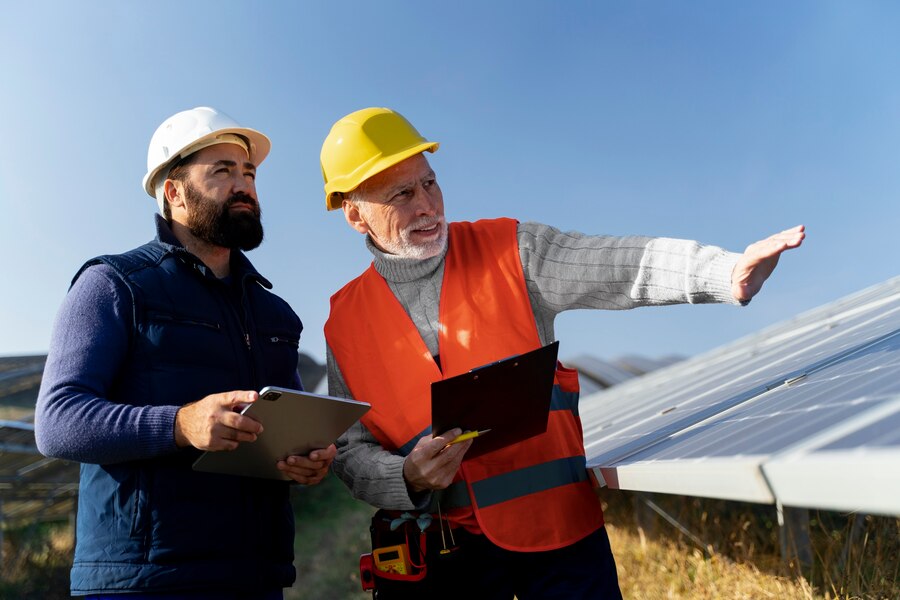Introduction
Investing in a 5 MW solar plant, typically costing around 18 to 20 crores, necessitates a strategic approach to ensure profitability and longevity of the installation. The expected operational lifespan of such a plant is approximately 25-30 years. One of the critical elements of this strategy is the earthing system.
Importance of Earthing in Solar Plants
Earthing, also referred to as grounding, establishes an electrical connection between conductive parts of a solar plant, such as solar panels, and the ground. This connection is vital for several reasons:
- Protection from Electrical Shocks: It safeguards personnel and equipment from potential electrical shocks.
- Dissipation of Electrical Surges and Lightning Strikes: It helps in dissipating the energy from electrical surges and lightning strikes, protecting the equipment.
- Stable Reference Point for Electrical Measurements: It provides a stable reference point for accurate electrical measurements.
Without proper earthing, solar panels and associated electrical equipment are vulnerable to damage from electrical disturbances. Such disturbances can lead to operational failures, necessitating costly repairs or replacements.
Role of Earthing
Earthing plays a pivotal role in ensuring the protection and efficiency of a solar farm. Its benefits include:
- Extending the Lifespan of Solar Panels and Electrical Equipment: Proper earthing helps in extending the operational life of the solar panels and other electrical components.
- Shielding from Electrical Surges and Lightning: It protects the solar farm from electrical surges and lightning, which can otherwise cause significant damage.
- Reducing Electrical Hazards: By providing a safe pathway for electrical faults, earthing reduces the risk of electrical hazards.
Maintaining an effective earthing system is crucial for the safe and efficient operation of solar farms, thereby maximizing the return on investment.
Calculating Earthing Requirements
The earthing requirements for solar installations depend on several factors, including soil resistivity and the layout of the solar panels. The following steps outline the process of calculating these requirements:
1. Determine Earth Resistance: The earth resistance is a measure of how well the earthing system can conduct electricity to the ground. This can be determined using an earth resistance tester, and measurements should be taken at various points around the solar farm to get an accurate reading.
2. Select Earthing Electrodes: Based on the measured earth resistance and the layout of the solar farm, appropriate earthing electrodes should be selected. These may include earthing plates, rods, or pits. The choice of electrodes will depend on the specific requirements of the solar farm and the characteristics of the soil.
3. Design the Earthing System: The design of the earthing system should ensure an effective connection between the solar panels and the ground. This involves placing earthing electrodes at strategic locations around the farm and connecting them to the panels using suitable conductors, such as copper or aluminum.
4. Test the Earthing System: After installation, the earthing system must be tested to verify its effectiveness. This involves using a ground resistance tester to measure the earth resistance at multiple points around the farm. If the measurements indicate that the system is not providing adequate grounding, adjustments may be necessary.
Earthing Design Standards
Several standards guide the design and installation of earthing systems for solar farms:
- IEC 60364 & IEC 62561: These International Electrotechnical Commission standards provide guidelines on the installation of earthing systems to ensure safety and efficiency.
- BS 7430: The British Standard for earthing provides comprehensive instructions on the design, installation, and testing of earthing systems.
- IEEE 2778-2020: The Institute of Electrical and Electronics Engineers guidelines offer detailed specifications for earthing systems in various electrical installations, including solar farms.
Adhering to these standards ensures that the earthing system is effective and reliable.
Expert Consultation
Engaging an earthing expert is beneficial for several reasons:
- Design and Installation: Experts provide guidance on the appropriate design and installation of the earthing system, ensuring it meets all necessary specifications.
- Performing Calculations: They assist in performing detailed calculations to determine the size and configuration of the earthing system, taking into account factors such as soil resistivity, the size and type of solar panels, and the location of the farm.
- Conducting Tests: Experts use specialized equipment to measure the ground resistance and other parameters, ensuring the system provides adequate grounding.
Common Issues and Solutions
Failure to meet earthing requirements can lead to increased electrical hazards and reduced reliability of the solar farm. Potential issues include:
- Improper Design: An earthing system that is not correctly designed may fail to provide adequate grounding.
- Installation Errors: Mistakes during installation can compromise the effectiveness of the earthing system.
- System Degradation: Over time, components of the earthing system may degrade, reducing its effectiveness.
Addressing these issues involves:
- Redesigning the Earthing System: If the system does not meet the required specifications, it may need to be redesigned. This could involve adding more grounding rods or using different conductive materials.
- Implementing Additional Safety Measures: To protect against electrical hazards, additional safety measures such as surge protectors can be installed. Regular testing and maintenance can also ensure the system continues to function effectively.
Maintenance of Earthing Systems
Regular inspection and maintenance of the earthing system are crucial for its long-term effectiveness. The following steps outline the maintenance process:
1. Locate and Inspect Components: Identify the grounding rods and other components of the earthing system. These may be located near the base of each solar panel or in a central area of the farm. Visually inspect them for signs of corrosion, wear, or damage.
2. Test the System: Use a ground resistance tester to measure the effectiveness of the earthing system. This helps identify any areas where the system may not be working correctly.
3. Repair or Replace Damaged Components: If any components are found to be damaged or faulty, they should be repaired or replaced promptly. This may involve replacing corroded grounding rods or frayed grounding wires.
4. Manage Moisture Levels: In areas with a high-water table or other potential sources of moisture, take steps to prevent moisture from affecting the earthing system. This may include installing drainage systems around the grounding rods.
Conclusion
Proper earthing is essential for the safe and efficient operation of solar farms. Adhering to design standards and engaging qualified professionals for installation and maintenance ensures the longevity and performance of the solar investment. Regular maintenance and addressing any issues promptly can prevent electrical hazards and ensure the reliability of the solar farm.
For further assistance, consulting with our expert engineers can provide tailored solutions for implementing and maintaining effective earthing systems in solar plants.







